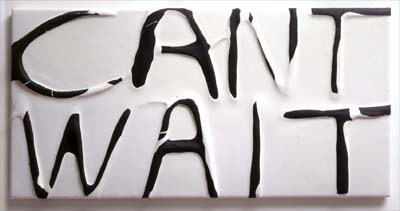 Maria Chevska Can't Wait (Letters R.L.) Awaiting the visitor to her first solo show in London for almost three years are two significant developments in Maria Chevska's work. The first is the introduction of objects into the gallery space, objects that the viewer has to negotiate and which act as both an aid and a restriction to reading her paintings. And the second is that this exhibition is suffused with one voice only, rather than the conversation between literary figures that has been a feature of Chevska's distinctive use of short, fragmented texts. The voice is Rosa Luxemburg's, "Blutige Rosa" - Bloody Rosa, the revolutionary most often portrayed as socialist heroine and the victim of her assassins. Having alighted on her subject, Chevska was drawn to a specific quality of language in Luxemburg's speeches and letters, her gift for persuasion. As before, Chevska's paintings tend to want to mix with other art forms, jamming as it were through their physical bulk and predilection for an activated setting, with the media associated with sound, weight, space, architecture. Words are a gift to her for all these reasons, but when she cited Kafka and Raymond Carver, as she did from the mid-1990s, she picked out passages of everyday unremarkableness seemingly at odds with her sources' reputations. That direction seemed right then to her sense of her medium: neither text nor painting was "elevated", but the elemental nature of each was complementary, in conversation. In her new work, that dialogue is recentred on dual facets of one source: the public exhortations of the Polish-born agitator as she roused Berlin workers to mass action to drive the revolution forward, and the words extracted from private letters to her fellow revolutionary, Leo Jogiches, a lifelong friend and sometime lover. In both lurks Luxemburg's dynamic and passionate personality, whether chastising her distant lover or urging the comrades around her out of disillusion from a momentary setback; "Act! Act!" one painting clamours. And the two overlap - how do we interpret "Can't Wait?" - so when she writes that "My night's vision was merely a dream...", it could equally apply to her feelings for Leo (to whom it was expressed) as to her unrealised humanitarian theory of Marxism. Chevska's paintings parallel the Luxemburg she perceived in her writing: bolshy, impetuous, urgent, impassioned. Edges are left messy in RL's eloquent utterances as refinement might blunt them. And it is the private words that Chevska pours on to banner-like rectangles as the trumpet calls of the street settle on white tablet that resemble pages. Luxemburg's career culminated in the bloody political ferment that surrounded Germany's surrender in 1918, and led to her murder by reactionary troops the following January. That timespan typifies for Chevska the broader tumult that ran a seismic wave through the arts, setting off an equally fierce critical reaction. Tatlin and Duchamp were comparable revolutionaries, and Berlin Dadaists were stripping away painting's aloofness and sticking canvases into their performances or on the street to expose the medium's vulnerability. The objects in the gallery act a little like such a Berlin street scene, impeding and provoking the viewer into a different relationship with the work on or, "flâneur"-like, against the wall. Kaolin-stiffened prosthetic abstract forms have appeared in Chevska's British shows before, but not the furniture. With their overtones of the studio (Chevska's setting) and (in the Panton chair) domestic modernism, they provide the pivot on which that moment around us turns. Like the Tatlin Tower-shaped spiral on a globe, the setting of this show spins some presumptions about painting on their axis. This text © Martin Holman, 2004. Exhibition: 24 March - 8 May, 2004 Gallery hours: Wed-Sat 12 am - 6 pm Andrew Mummery Gallery Studio 1.4 - The Tea Building 56 Shoreditch High Street UK-London E1 6JJ Telephone/Fax +44 (0)20 7729 9399 Email info@andrewmummery.com www.andrewmummery.com |